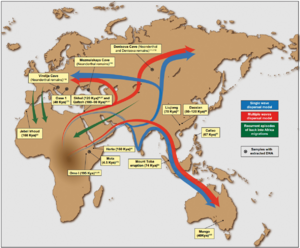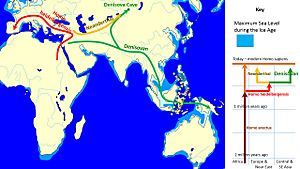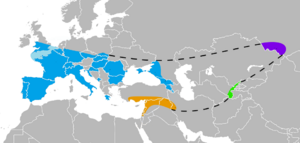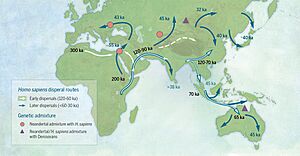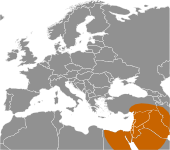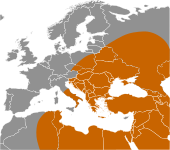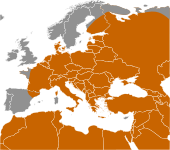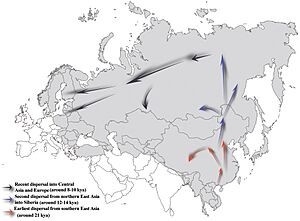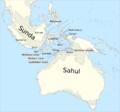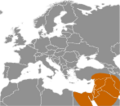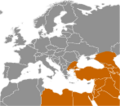Early human migrations facts for kids
Early human migrations are the amazing journeys our ancient ancestors took as they spread across the Earth. These movements started about 2 million years ago. The first to leave Africa were early human types like Homo erectus. They likely walked across land bridges that are now covered by water.
Later, other ancient human groups, such as Homo heidelbergensis, also moved around. These groups lived about 500,000 years ago. They were likely ancestors of Denisovans and Neanderthals, as well as humans like us.
Our own species, Homo sapiens (modern humans), first appeared in Africa about 300,000 years ago. Scientists believe that all modern humans outside of Africa came from a group that left East Africa. This big journey happened about 70,000 to 50,000 years ago. They spread along the southern coast of Asia and reached Oceania (like Australia) around 50,000 years ago. Modern humans then spread across Europe about 40,000 years ago.
Some very old Homo sapiens fossils have been found in Israel and Greece. They are about 194,000 to 210,000 years old. These might have been early attempts to leave Africa that didn't last. These groups were probably replaced by local Neanderthals.
As modern humans moved, they sometimes mixed with other ancient human groups. This means that people today have a small amount of DNA (less than 10%) from these older human types.
After the Last Glacial Maximum (a very cold period), people from northern Eurasia moved to the Americas. This happened about 20,000 years ago. The Arctic parts of Canada and Greenland were reached by the Paleo-Eskimo people about 4,000 years ago. Finally, Polynesia was settled in the last 2,000 years by people using boats.
Contents
Early Human Journeys (Before Homo sapiens)
The very first humans developed from ape-like ancestors about 3 million years ago. This likely happened in Eastern Africa, where the oldest known stone tools were found. Stone tools found in China, dated to 2.12 million years ago, suggest that early humans left Africa even earlier than thought.
Homo erectus Spreads Out
Between 2 million and 1 million years ago, a human type called Homo erectus spread across East and Southern Africa. Around 1.8 million years ago, Homo erectus started moving out of Africa. They used paths like the Levantine corridor (near the Middle East) and the Horn of Africa.
Homo erectus spread across much of the Old World, reaching as far as Southeast Asia. We can trace their path by the simple stone tools they left behind. They reached places like Pakistan, the Middle East, and Georgia.
In Prehistoric China, there is evidence of Homo erectus from 2.12 million years ago. Tools found in northern China are 1.6 to 1.7 million years old. The site of Xihoudu in China shows the earliest known use of fire by Homo erectus, about 1.27 million years ago.
Homo erectus reached Southeast Asia (like Java) about 1.7 million years ago. They arrived in Western Paleolithic Europe around 1.2 million years ago. Some scientists even think Homo erectus might have built rafts and sailed across oceans, but this idea is debated.
After Homo erectus
Over a million years after Homo erectus first spread, new human species began to appear. Homo erectus slowly changed into these new types. For example, Homo antecessor appeared in Europe around 800,000 years ago. Homo heidelbergensis appeared in Africa around 600,000 years ago.
Homo heidelbergensis then spread across East Africa and into Eurasia. In Eurasia, they gave rise to Neanderthals and Denisovans. These groups moved far north, even beyond the 50th parallel (a line of latitude). Some evidence suggests that late Neanderthals might have reached the edge of the Arctic about 32,000 years ago. This was when modern humans were taking over their old homes.
Other ancient human species likely spread across Africa, but we don't have many fossils. We know they were there because modern African populations have some of their DNA. For example, Homo naledi, found in South Africa, lived about 300,000 years ago.
Neanderthals spread across the Middle East and Europe. Denisovans seem to have spread across Central and East Asia, and even into Southeast Asia and Oceania. There's proof that Denisovans and Neanderthals mixed in Central Asia where they lived near each other. Neanderthal remains have been found very far north in the Ural Mountains, suggesting they might have found a safe place there during very cold times.
Homo sapiens Journeys
Spreading Across Africa
Scientists believe Homo sapiens first appeared in Africa about 300,000 years ago. This is based on fossils and tools found in Morocco and South Africa. The oldest known fossils of Homo sapiens were found in Ethiopia and are about 200,000 years old.
In 2019, scientists used computer scans to guess what the skull of our earliest modern human ancestor looked like. They suggested that modern humans appeared between 260,000 and 350,000 years ago. This happened as different groups in East and South Africa came together.
Also in 2019, scientists found 210,000-year-old Homo sapiens remains in Greece. This is much older than any other Homo sapiens found in Europe before.
Early modern humans spread across Western Eurasia and Central, Western, and Southern Africa. While early trips to Eurasia didn't last, the movements into Southern and Central Africa led to the oldest differences in human populations today. Modern humans spreading in Africa helped end the older stone tool-making ways around 130,000 years ago.
The ancestors of the modern Khoi-San people moved to Southern Africa before 150,000 years ago. By 130,000 years ago, there were two main groups in Africa. One group in southern Africa became the Khoi-San. The other group in central/eastern Africa became the ancestors of everyone else.
People who became the ancestors of Central African foragers (African Pygmies) likely moved into Central Africa before 130,000 years ago.
It's harder to understand what happened in West Africa because there are fewer fossils. Homo sapiens seems to have reached the western Sahel area by 130,000 years ago. But older stone tool sites continued to be used there much later, suggesting that ancient humans might have lived there longer and mixed with Homo sapiens.
Early Journeys to Northern Africa
Some groups of Homo sapiens traveled to the Middle East and Europe between 130,000 and 115,000 years ago. Some might have even gone earlier, around 185,000 years ago.
A jawbone found in Israel, about 185,000 years old, shows this. Tools found in the same cave suggest that humans might have left Africa even earlier.
However, these early journeys didn't lead to lasting settlements. These groups likely died out around 80,000 years ago. It's possible this first wave even reached China or North America, but they didn't leave a genetic trace in people today.
There's some proof that modern humans left Africa at least 125,000 years ago using two paths. One was through the Nile Valley to the Middle East (Israel). The other was across the Bab-el-Mandeb Strait (a narrow sea passage) to the Arabian Peninsula. They settled in places like the United Arab Emirates and Oman. They might have even reached India. While no human bones have been found in these places, the tools look similar to those from Africa. This suggests modern humans made them. These findings might support the idea that modern humans reached southern China about 100,000 years ago.
Since these early groups didn't leave much genetic evidence in people today, it seems they didn't survive in large numbers. A huge volcanic eruption (the Toba eruption) about 74,000 years ago might have caused a very cold period. This could have reduced human populations to very small groups, explaining why their genes aren't common today.
Coastal Migration: The Big Spread

The most important "recent dispersal" of modern humans happened about 70,000 to 50,000 years ago. This is the migration wave that led to modern humans spreading across the entire world.
A small group from East Africa, perhaps fewer than 1,000 people, crossed the Red Sea strait into what is now Yemen. This happened after about 75,000 years ago. Their descendants spread along the coast of Arabia and Persia to India before 55,000 years ago. Other research suggests this migration out of Africa happened between 65,000 and 50,000 years ago.
As they moved, Homo sapiens mixed with Neanderthals and Denisovans. For example, Denisovan DNA makes up about 0.2% of the DNA in people from mainland Asia and Native Americans.
Reaching Nearby Oceania
The migrations continued along the Asian coast to Southeast Asia and Oceania. People settled Australia around 65,000 to 50,000 years ago. By reaching Australia, Homo sapiens went further than Homo erectus ever did. People in Melanesia, Aboriginal Australians, and some groups in Southeast Asia (like the Mamanwa in the Philippines) have Denisovan DNA. This suggests that mixing happened in Eastern Asia where Denisovans lived.
During this time, sea levels were much lower. Most of Maritime Southeast Asia was one big landmass called Sunda. People continued to move southeast along the coast to the narrow passages between Sunda and Sahul (the landmass of Australia and New Guinea). These gaps were up to 90 km wide, so people needed boats to reach Australia and New Guinea. Migration also continued along the coast, eventually turning northeast to China and then reaching Japan.
Genetic studies of Aboriginal Australians show they came from people who migrated into East Asia between 62,000 and 75,000 years ago. This supports the idea of a single migration into Australia and New Guinea. This migration is thought to have happened around 50,000 years ago, before Australia and New Guinea were separated by rising sea levels about 8,000 years ago.
Spreading Across Eurasia
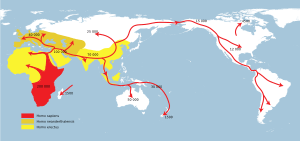
The group of people who reached South Asia by coastal migration stayed there for some time, from about 60,000 to 50,000 years ago. Then, they spread further across Eurasia. This spread of early humans, at the start of the Upper Paleolithic period, led to the main population groups we see in the Old World and the Americas today.
Towards the West, these groups spread across Asia and Europe. There was also a movement back to North Africa and the Horn of Africa many thousands of years ago.
Modern humans were definitely in Europe after 40,000 years ago, possibly as early as 43,000 years ago. They quickly replaced the Neanderthal population there. Europeans today have some Neanderthal DNA, but it seems that most mixing with Neanderthals happened before 47,000 years ago, before modern humans entered Europe.
There is evidence that modern humans went through a "genetic bottleneck." This means that the number of humans was greatly reduced, which lowered the variety in our genes. Some scientists think that humans spread from a small area about 100,000 years ago. Then, about 50,000 years ago, there was a dramatic growth in populations that were spread out. The huge eruption of Lake Toba (a volcano) might have caused a 1,000-year cold period. This could have reduced human populations to as few as 15,000 people. However, recent studies suggest that non-African populations came from multiple sources, not just one.
Europe
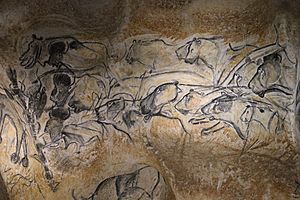
Modern humans reached Europe around 40,000 years ago. They came from Central Asia and the Middle East. They had learned how to hunt large animals in cold, grassy areas. Neanderthals were already in the Middle East and Europe. The new modern human groups (also called "Cro-Magnon") mixed with Neanderthal populations a little bit. Modern humans and Neanderthals lived in the same areas in places like Spain and the Middle East.
Europe was different from other inhabited places because it was so far north. Archaeological finds show that humans, both Neanderthals and Cro-Magnons, reached sites in Arctic Russia by 40,000 years ago.
Cro-Magnons are considered the first modern humans in Europe. They entered Eurasia through the Zagros Mountains (near Iran and Turkey) around 50,000 years ago. One group quickly settled coastal areas around the Indian Ocean. Another group moved north to the wide grasslands of Central Asia. Modern human remains from 43,000 to 45,000 years ago have been found in Italy and Britain. They have also been found in the European Russian Arctic from 40,000 years ago.
Humans settled the areas west of the Ural Mountains. They hunted reindeer, but faced big challenges. Winter temperatures were very cold, and fuel and shelter were hard to find. They walked everywhere and relied on hunting moving herds for food. They overcame these problems with new ideas: making tailored clothes from animal furs, building shelters with fires using bones as fuel, and digging "ice cellars" to store meat.
The spread of modern human populations is thought to have started 45,000 years ago. It might have taken 15,000 to 20,000 years for Europe to be fully settled.
During this time, Neanderthals were slowly pushed out. Because it took so long, it seems humans and Neanderthals were constantly competing for land. Neanderthals had larger brains and were stronger, which suggests they were physically tougher than modern Homo sapiens. They had lived in Europe for 200,000 years, so they were better used to the cold. But the Cro-Magnons had better trade networks, more advanced tools, and bodies that were probably better for running. They eventually completely replaced the Neanderthals. The last known Neanderthals lived in a cave system in Gibraltar from 30,000 to 24,000 years ago. After about 25,000 years ago, we find no more Neanderthal fossils, meaning they died out.
Genetic studies suggest that the last time Neanderthal genes entered the ancestors of Europeans was 47,000 to 65,000 years ago. This mixing likely happened somewhere in Western Eurasia, possibly the Middle East. Studies show that people in East Asia have more Neanderthal DNA than Europeans. People in North Africa have similar amounts of Neanderthal DNA as non-African populations. But groups in Sub-Saharan Africa are the only modern human populations with almost no Neanderthal DNA.
East, Southeast, and North Asia
"Tianyuan man", a person who lived in China about 40,000 years ago, had a lot of Neanderthal DNA. A 2017 study of Tianyuan Man's ancient DNA found that this person was related to modern Asian and Native American populations. A 2013 study found that 18 genes from Neanderthals were passed into East Asian populations. These genes became more common in East Asian populations, especially from 45,000 years ago until about 5,000 to 3,500 years ago. They are very common in East Asian populations compared to other groups. This suggests that this mixing with Neanderthals happened in the common ancestors of East Asians and Native Americans.
A 2016 study looked at the genes of the Ainu people of northern Japan. They found that the Ainu are a very old group, suggesting a link to people from northeast Siberia from long ago.
Groups of people with certain genetic markers (mitochondrial haplogroups A, B, and G) appeared about 50,000 years ago. These groups then settled Siberia, Korea, and Japan by about 35,000 years ago. Some of these groups moved to North America during the Last Glacial Maximum.
A 2022 review paper suggested that a special "Basal-East Asian population" (called ESEA) was the ancestor of modern East Asians, Southeast Asians, Polynesians, and Siberians. This group started in Mainland Southeast Asia around 50,000 BC. They spread in many waves, both south and north. This ESEA group is also the ancestor of the Hoabinhian hunter-gatherers of Southeast Asia and the 40,000-year-old Tianyuan man in China.
Last Glacial Maximum: A Cold Period
Eurasia
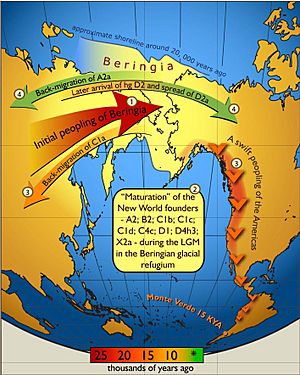
Around 20,000 years ago, about 5,000 years after Neanderthals died out, the Last Glacial Maximum (LGM) happened. This was a very cold period that forced people in the northern half of the world to move to warmer, safer places. These groups stayed in these "refuges" until the LGM ended. They then moved back into Europe. Later, other migrations changed the makeup of European populations, especially with farmers from the Middle East and groups from the Indo-European expansion. A very old site in Siberia, far above the Arctic Circle, shows that people adapted to this harsh, cold environment much earlier than thought, about 27,000 years ago.
Americas
The Paleo-Indians came from Central Asia. They crossed the Beringia land bridge, which connected eastern Siberia to what is now Alaska. Humans lived across the Americas by the end of the last ice age. Scientists are still studying the exact dates and routes of these early migrations.
Most estimates suggest humans reached North America between 15,000 and 20,000 years ago. The common idea is that these early travelers moved when sea levels were very low due to the ice age. They followed herds of large, now-extinct animals along paths that were free of ice. Another idea is that they traveled down the Pacific coast by foot or in simple boats, reaching as far as Chile in South America. Any old evidence of coastal settlements would now be covered by the sea, which has risen by a hundred meters since then. Recent genetic findings in the Amazon support the idea that some migrants used a coastal route.
Holocene Migrations (After the Ice Age)
The Holocene period began 12,000 years ago, after the Last Glacial Maximum ended. During a warmer period called the Holocene climatic optimum, starting about 9,000 years ago, human populations began to move out of their refuges. By this time, most parts of the world were settled by Homo sapiens. However, large areas that had been covered by glaciers were now re-settled.
This period saw the change from the Mesolithic (Middle Stone Age) to the Neolithic (New Stone Age). The Neolithic then led to the Bronze Age, and the start of written history in the Middle East and China around 4,000 years ago.
Large migrations during the Mesolithic and Neolithic eras are thought to have created the way the world's major language families are spread today. These include groups like Niger-Congo, Afro-Asiatic, Uralic, Sino-Tibetan, and Indo-European.
Eurasia
New evidence from ancient human DNA suggests that modern native populations of Europe mostly came from three different groups. These were "Western Hunter-Gatherers" (descendants of Europe's Cro-Magnon people), "Early European Farmers" (who came from the Middle East during the Neolithic Revolution), and "Ancient North Eurasians" (who spread to Europe as part of the Indo-European expansion).
Sub-Saharan Africa
Migrations from Western Eurasia into Africa started in the early Holocene or even earlier. These were followed by more migrations from the Middle East during the Neolithic period. These movements mostly affected North Africa, the Horn of Africa, and parts of the Sahel and East Africa.
The Nilotic peoples are thought to have come from an earlier group around 3,000 BCE. They likely started as herders. The Niger-Congo language family is thought to have started around 6,000 years ago in West or Central Africa. Its spread might be linked to the growth of farming in Africa after the Sahara desert became drier around 3900 BCE. The Bantu expansion spread Bantu languages across Central, Eastern, and Southern Africa. These groups partly replaced the original populations, like the African Pygmies and San people. This expansion started about 3,000 years ago and reached South Africa about 1,700 years ago.
Some studies suggest that there was mixing from ancient and recent migrations from Eurasia into parts of Sub-Saharan Africa. This mixing varies by region, being higher in the Horn of Africa and parts of the Sahel, and less common in other areas.
Indo-Pacific

The first human migrations by sea were made by the Austronesian peoples. They came from Taiwan. Using advanced sailing technologies like catamarans and outrigger boats, they built the first sea-going ships. They quickly settled Island Southeast Asia between 3000 and 1500 BCE. From the Philippines and Eastern Indonesia, they settled Micronesia by 2200 to 1000 BCE.
A group of Austronesians reached Island Melanesia between 1600 and 1000 BCE. They created the Lapita culture, known for its special pottery. These people are the direct ancestors of modern Polynesians. They sailed into the distant Pacific Ocean, reaching Vanuatu, New Caledonia, and Fiji by 1200 BCE. They reached Samoa and Tonga by 900 to 800 BCE. This was the furthest the Lapita culture spread. Over about 1,500 years, they lost the skill of making pottery. They used carved wooden and bamboo containers instead. Later, some Lapita groups moved back into Island Southeast Asia and Micronesia. It wasn't until 700 CE that they sailed further into the Pacific. They settled the Cook Islands, Society Islands, and Marquesas. From there, they settled Hawaii by 900 CE, Rapa Nui by 1000 CE, and New Zealand by 1200 CE.
In the Indian Ocean, Austronesians from Borneo also settled Madagascar and the Comoros Islands around 500 CE. Austronesians are still the main language group in the islands of the Indo-Pacific. They were the first to create a sea trade network that reached as far west as East Africa and the Arabian Peninsula. They mixed with earlier groups who had migrated through Sundaland, like the Papuans and Negritos. The Austronesian expansion was the last and most widespread human migration during the Neolithic period.
Caribbean
The Caribbean islands were some of the last places in the Americas to be settled by humans. The oldest remains are from Cuba and Hispaniola, dating between 4000 and 3500 BCE. Tools suggest these people came from Central America, across the Yucatán Channel. All evidence shows that later migrants, from 2000 BCE onwards, came from South America, through the Orinoco region. The descendants of these migrants include the ancestors of the Taíno and Kalinago peoples.
Arctic
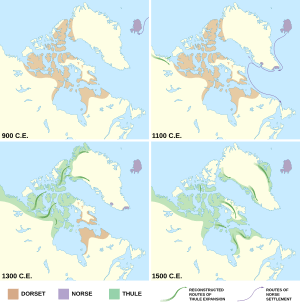
The earliest people in North America's central and eastern Arctic are called the Arctic small tool tradition (AST). They lived around 2500 BCE. AST included several Paleo-Eskimo cultures.
The Inuit people are descendants of the Thule culture. This culture appeared in western Alaska around 1000 CE. They slowly replaced the Dorset culture as they spread.
Images for kids
-
Overview map of how early humans spread around the world during the Upper Paleolithic period, mostly following the coast.
-
Successive dispersals of Homo erectus (yellow), Homo neanderthalensis (ochre), and Homo sapiens (red).
-
This 30,000-year-old painting of cave lions and bison was found in the Chauvet Cave in France.
-
Ancient North Eurasian populations from Siberia were an important genetic contributor to Ancient Native Americans and Eastern European Hunter-Gatherers.
-
This map shows how people moved across Beringia (the land bridge between Asia and North America). Central Asian groups arrived around 25,000 years ago, followed by a quick settlement of the Americas around 15,000 years ago.
-
This map shows when and where the Austronesian expansion happened across the Pacific.
-
This map shows the decline of the Paleo-Eskimo Dorset culture and the spread of the Thule people (900 to 1500 CE).
See also
 In Spanish: Expansión de la humanidad para niños
In Spanish: Expansión de la humanidad para niños


